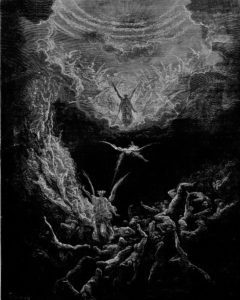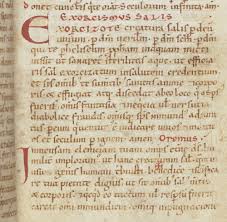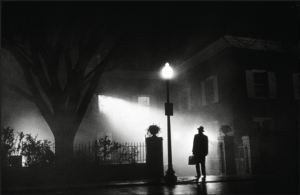Exorcism is mainly thought of as the rite of driving out the Devil and his demons from possessed persons. Exorcism is mainly performed in incidences of demonic possession that is generally distinguished from spiritual possession. A general assumption is that the Roman Catholic singularly practices the rite of exorcism, but some Protestant denominations such as the Pentecostals and other charismatic groups practice it as well. These groups refer to the practice as “deliverance ministry” where gifted people drive out devils and heal while they touch the persons with their hands, called laying on of hands, and pray over them.
Technically, exorcism is not driving out the Devil or a demon, but it is placing the Devil or demon on oath. And, in some incidences there may be more than one demon possessing a person. “Exorcism” is derived from the Greek preposition ek with the verb horkizo which means “I cause [someone] to swear” and refers to “putting the spirit or demon on oath,” or invoking a higher authority to bind the entity in order to control it and command it to act contrary to its own will.
In the Christian sense this higher authority is Jesus Christ. This act is based on the belief that the Devil, his demons, and evil spirits are afraid of Christ. The belief itself is based on Scripture. Coming from the sea of Galilee Christ entered the land of the Gerasenes. He was immediately met by a man from the tombs cut into the mountains of the area. The man was said to be possessed of an unclean spirit. Nothing could bind this man, not even chains. He lived in the mountains, crying, and cutting himself with stones. But, so it is told, when seeing Christ approaching, the man went to him seeking help. The unclean demon immediately recognized Christ, and Christ recognized the demon. Christ summoned the spirit to leave the man, and asked his name. “My name is Legion,” answered the spirit, “for we are many.” Once the demons left the man Christ sent them into a nearby heard of swine who then jumped in to the sea and drown. (Mark 5:1-13) Unlike other exorcists, it is believed, that Christ did not exorcise because He did not need to call on a higher authority since He Himself was that higher authority.
Not only did Christ exorcize demons, or unclean spirits, but he gave the powers to his disciples. “…he gave the power against unclean spirits, to cast them out, and to heal all manner of sickness, and all manner of disease.” (Matt.10:1)
From these two Biblical passages and others Catholics and Protestants alike believe they have the power to cast out the Devils and to heal. The Catholic Church has a procedure out-lined rite of exorcism which is set forth in “The Rituale Romanum” Other than this text the ritual has great variance determined by the exorcist performing the exorcism. The code of Cannon Law allows authorized ministers (the exorcists) to perform solemn exorcisms not only over the faithful, but also over non-Catholics and those who have been excommunicated from the Church.
During the ritual usually salt, representing purity, and wine, representing the blood of Christ, is present. The victim is to hold a crucifix during the rite. The exorcist is encouraged to use holy water and relics, usually pieces of bones from Saints, and recite Biblical scriptures and other prayers.
The greatest danger to the exorcist is becoming possessed by the Devil or demon himself. This is the reason why the exorcist must feel as free of sin as possible and feel no secret need for punishment. Otherwise the Devil or demon can easily entrap him. An example of this is Father Jean-Joseph Surin, the Jesuit exorcist of Loudun, who became possessed while ministering to Sister Jeannes des Angest. Surin was reared in a cloister, practiced severe self-denial during his early years as a priest, experienced severe muscle pains, and had virtually cut himself off from all social contact which led him to come to the Sisters’ Convent in poor health and a confused state of mind. Unlike his fellow Jesuits he was thoroughly convinced Sister Jeanne and her companion Sisters were truly possessed. Author Aldous Huxley in his “The Devils of Loudun” (1952) described Surin’s mental state as one of “pathological illiteracy.”
This is possibly the reason that Malachi Martin, a former Jesuit professor, claimed in his book “Hostage to the Devil” (1976), that much of the success of the exorcism depends upon the exorcist. He describes the type of priest best suited to be an exorcist as being a man of good physical health, being of middle age, routinely going about his normal pastoral duties. He usually is not brilliant or engaged in teaching or research. Although Martin adds, there are exceptions to all these characteristics.
In his book Martin also describes the setting where the exorcism takes place. It is usually in a location where there is a definite connection between the demon and the victim, like the victim’s bedroom or resident.
But again to Martin, the most important thing is the exorcist’s disposition and those of his assistants. Presently few exorcists choose to work alone. Three other people usually assist the exorcist. One is a junior priest who has been trained in exorcism procedures. He monitors the exorcism, helping the exorcist when possible not to be distracted by the possessive demon. Others can include a medical physician and a family member. The most important thing of all is that the exorcist and his assistants be physically strong and relatively guiltless. None must have any secret sins which the Devil or demon can use against them. In some incidences the Devil or demons may shout out the sins of the exorcist or his assistants attempting to shame them and ruin the exorcism.
Although all exorcisms are different in proceeding there are similar stages they follow. Martin describes these stages:
The Presence: The exorcist and his assistants become aware of an alien feeling or entity. Attempts or actions of the evil spirit appear to be the victim’s. The exorcist’s first job is to break this Pretense and find out whom the demon really is. Gaining the entity’s name is most important.
Breakpoint: The moment when the Devil’s Pretense finally collapses. This is usually a moment of complete pandemonium. There evolves a scene of panic and confusion accompanied by a crescendo of abuse, horrible sights, noises, and odors. The Devil then turns on the victim, speaking of the person in the third person.
The Voice: Also a sign the Breakpoint, the Voice (of the demon) becomes “inordinately disturbing and humanly distressing babble.” The demon’s voices must be silenced for the exorcism to proceed.
The Clash: As the Voices die out there is both a spiritual and physical pressure. The demon has collided with the “Will of the Kingdom.” The exorcist is now in direct battle with the demon urging the entity to reveal more information about itself so it can be controlled. As previously mentioned there is a connection between the entity and the victim’s resident. The entity wants a place to be in or it must return to Hell. An existence out of Hell is what the Devil or demon is fighting for.
Expulsion: In the supreme triumph of God’s will the demon or spirit leaves in the name of Jesus. All present feel the Presence dissipates occasionally with receding noises and voices. The victim may remember the ordeal or may not recall anything that has happened.
The ritual of exorcism is more cautiously employed by the Catholic Church at present than it once was. When reviewing the conditions for demonic possession that were once listed one can easily see many of the symptoms are those of epilepsy, hysteria, schizophrenia, and other psychological disorders. So priests are cautioned to be as certain as possible the person is truly demonically possessed before performing the ritual.
In some incidences this precaution may not be enough to guard an innocent person against the ritual. For example, Saint Paul exorcized a slave girl who made much money for her masters by soothsaying. (Acts 16:16-18) Today, occultists call such acts prophecy. Catholics are still forbidden to visit fortune tellers. Other religions such as Judaism, Hinduism, Buddhism, Islam, Shinto and others have some form of exorcism rituals. One of the best known Judaic rituals, cited in Judaism rabbinical literature dating from the first century AD, concerns the dybbuk, an evil or doomed spirit which possesses a victim and causes mental illness and a personality change. The dybbuk is expelled through the victim’s small toe, and then is either redeemed or sent to hell.
In many Eastern religions spirits and ghosts are blamed for many ills, and are cast out of people. However such afflictions are not regarded as all-out battles for the persons’ souls. The ritual employed in Shamanism is that the shaman enters a trace during which he attempts to discover the cause of the victim’s trouble. Frequently the cause is thought linked to a dead person. The shaman then is said to travel to the Lowerworld to speak with this soul. He then knows the cure of this victim’s affliction, or may even bring back the soul to cure it.
All persons do not consider the purpose of the ritual of exorcism as expelling the spirit as condemning it to hell as do the Christians. Some, including occultists and Witches, do not consider the spirits demonic but at times become confuse and invade persons’ bodies. The purpose of this type of exorcism is to release the spirit. Then the spirit is free to journey onto its resting place or new life. Witches frequently are asked to exorcise ghosts and other unwanted psychic energy that trouble persons.
Spirit exorcisms, as cures of physical illnesses and solutions to other personal problems are common in Africa, Latin America, the Middle East, the Orient, and among tribal cultures.
Why are Exorcisms Performed?
The Roman Catholic Church lists symptoms of demonic invasion as a loss of appetite, unnatural body postures and a change in the person’s face, voice as well as predicting future events and a cold feeling in the room as well as an odor of sulfur. Other tell-tale signs include a person losing control and lashing out, an intense hatred toward religion or antipathy towards entering a church, speaking Jesus’ name or hearing scripture. Most reported cases do not require an exorcism because twentieth-century Catholic officials regard genuine demonic possession as an extremely rare phenomenon. Often someone will just need medical help.
How Does an Exorcism Work?
In the Catholic church the exorcist must be an ordained priest. They recite prayers and use religious materials such as a crucifix to invoke God – in the Name of Jesus Christ– to intervene with the exorcism. The possessed person may be restrained for their own protection. The Catholic Priest recites certain prayers such as the Our Father, Hail Mary, and the Athanasian Creed. It is important for the exorcist to finish the prayer otherwise the demon will pursue him. Sometimes exorcisms can take days, weeks or even months of constant prayer. In 1928 a Capuchin friar and Catholic priest Theophilus Riesinger performed a 23-day exorcism on an Iowa women who cried “My Jesus! Mercy! Praised be Jesus Christ!” when the demons were finally said to have been driven out.
Was “The Exorcist” Based on a True Story?
The film has shocked and horrified audiences since its release in 1973 but most don’t realize “The Exorcist” was actually based on true events. In the small city of Cottage City ,Maryland in 1949 a 14-year-old boy was the subject of a months-long exorcism performed by Jesuit priests. The teenager, who was given the pseudonym Roland Doe to protect his identity, was introduced to a Ouija Board by his aunt who was a spiritualist. The boy’s parents began to notice strange occurrences around him such as his bed shaking, furniture moving across the room and scratching noises coming from inside the walls. After his aunt’s death the boy’s parents met with Father Albert Hughes the Roman Catholic priest at Saint James Parish near their Maryland home. Father Hughes said he believed the boy was possessed and sought permission from the Archbishop of Washington DC to begin the rite of exorcism. Roland’s parents relocated him to a relative’s home in Saint Louis, Missouri, where over the course of several weeks as many as nine Jesuit priests including Father Bowdern participated in the boy’s exorcism. Another of them, Father Raymond Bishop, kept a diary of those encounters. During the exorcism the boy allegedly slipped one of his hands out of the restraints and broke a bedspring from under the mattress and used it as a weapon to slash the priest’s arm. During a second exorcism both priests visited Roland and observed a shaking bed, flying objects, the boy speaking in a guttural voice, and exhibiting an aversion to anything sacred. After the exorcisms Roland apparently went on to lead a normal life. He was married and raised children and maintained a long and productive career with the NASA before retiring reportedly to suburban Maryland. He has never spoken publicly about the case.
Anneliese Michel
Anneliese Michel was thought to be ‘possessed’ by six demons. In the 1970s Anneliese Michel, a 23-year-old student from Klingenberg, Germany after suffering severe convulsions from epilepsy began experiencing devilish hallucinations while praying. By 1973 she was suffering severe depression and considering suicide as voices in her head told her she was worthless, compelling her to perform 600 genuflections a day which would eventually rupture her knee ligaments. The deeply religious student crawled under a table and began to bark like a dog for two days. She ate spiders and coal and bit the head off a dead bird. She could be heard through the walls of her home screaming for hours. In 1975 her request for an exorcism was granted and was performed by Fr Arnold Renz and Pastor Ernst Alt.The priests identified several demons including Lucifer, Judas Iscariot, Nero, Cain just to name a few. Haunting voice recordings were made of Anneliese gurgling and talking about the horrors of Hell through one of the six demons she was possessed by. By the spring of 1976 Anneliese was suffering from pneumonia and emaciation. She died on July 1, 1976.Her parents Anna and Josef were put on trial for their daughter’s murder alongside the two priests who performed the exorcisms. All were found guilty of negligent homicide by allowing her to starve and given suspended six-month prison sentences and three years’ probation. The horrific ordeal was then basis for 2005 film The Exorcism of Emily Rose starring Jennifer Carpenter and the 2006 German movie Requiem.
My Involvement in “The Work”
For nearly thirty-five years I have been interacting and resolving issues within hauntings involving demonic energies. It has become commonplace today in many lives and homes as the boundaries and veils that once separated that realm dissipate and permissions are granted for the once forbidden upfront darker energies to take a place in the daily lives of human beings. It is my hope that as people begin to ascend spiritually this will strengthen the barrier to this realm and restore it to what it is intended for-a contrast for humanity to learn and deepen. Prior to my own issues with this realm and the subsequent cases I have assisted with I primarily held universal spiritual beliefs. It has certainly changed my world-view and perspective as a medium and a person who has the discernment of spirits-crystalizing and putting into perspective many of the blank holes in my belief system and realm of experiences.




